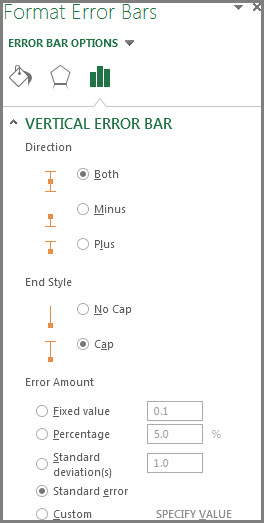
- HOW TO CALCULATE STANDARD ERROR IN EXCEL 2007 FOR MAC
- HOW TO CALCULATE STANDARD ERROR IN EXCEL 2007 SERIES
N y = total number of data values in all seriesĪpply a percentage of the value for each data point in the data seriesĪpply a multiple of the standard deviation, using the following formula:
HOW TO CALCULATE STANDARD ERROR IN EXCEL 2007 SERIES
Y is = data value of series s and the I th point

Point to Error Bars, and then do one of the following:Īpply the standard error, using the following formula: On the Chart Design tab, click Add Chart Element. In the chart, select the data series that you want to add error bars to.įor example, in a line chart, click one of the lines in the chart, and all the data marker of that data series become selected. For example, type 0.4, 0.3, 0.8.ĭo any of the following: Express errors as a percentage, standard deviation, or standard error In the Positive Error Value and Negative Error Value boxes, specify the worksheet range that you want to use as error amount values, or type the values that you want to use, separated by commas. To use custom values to determine the error amount, click Custom, and then do the following:

To use a different method to determine the error amount, click the method that you want to use, and then specify the error amount. Under Error Amount, do one or more of the following: On the Layout tab, in the Analysis group, click Error Bars, and then click More Error Bar Options. On the Format tab, in the Current Selection group, click the arrow next to the Chart Elements box, and then click the chart element that you want. This displays the Chart Tools, adding the Design, Layout, and Format tabs. On a 2-D area, bar, column, line, xy (scatter), or bubble chart, click the error bars, the data point, or the data series that has the error bars that you want to change, or do the following to select them from a list of chart elements: Ny = total number of data values in all seriesĪdd, change, or remove errors bars in a chart in Office 2010 Yis = data value of series s and the ith point M = number of series for point y in chart Excel uses the following equations to calculate the Standard Error and Standard Deviation amounts that are shown on the chart. People often ask how Excel calculates error amounts. Review equations for calculating error amounts You can remove either of these error bars by selecting them, and then pressing Delete. Scatter charts can show both horizontal and vertical error bars. Note: The direction of the error bars depends on the type of chart you’re using. In scatter and bubble charts, you can show error bars for x and y values.

You can use error bars in 2-D area, bar, column, line, xy (scatter), and bubble charts. For example, you can show a 10 percent positive and negative error amount in the results of a scientific experiment like this: You can set your own values to display the exact error amounts you want. They can be shown on all data points or data markers in a data series as a standard error amount, a percentage, or a standard deviation.

LessĮrror bars in charts you create can help you see margins of error and standard deviations at a glance.
HOW TO CALCULATE STANDARD ERROR IN EXCEL 2007 FOR MAC
Excel for Microsoft 365 Word for Microsoft 365 Outlook for Microsoft 365 PowerPoint for Microsoft 365 Excel for Microsoft 365 for Mac Word for Microsoft 365 for Mac PowerPoint for Microsoft 365 for Mac Excel 2021 Word 2021 Outlook 2021 PowerPoint 2021 Excel 2021 for Mac Word 2021 for Mac PowerPoint 2021 for Mac Excel 2019 Word 2019 Outlook 2019 PowerPoint 2019 Excel 2019 for Mac Word 2019 for Mac PowerPoint 2019 for Mac Excel 2016 Word 2016 Outlook 2016 PowerPoint 2016 Excel 2016 for Mac Word 2016 for Mac PowerPoint 2016 for Mac Excel 2013 Word 2013 Outlook 2013 PowerPoint 2013 Excel 2010 Word 2010 Outlook 2010 PowerPoint 2010 Excel 2007 Outlook 2007 Excel Starter 2010 More.


 0 kommentar(er)
0 kommentar(er)
